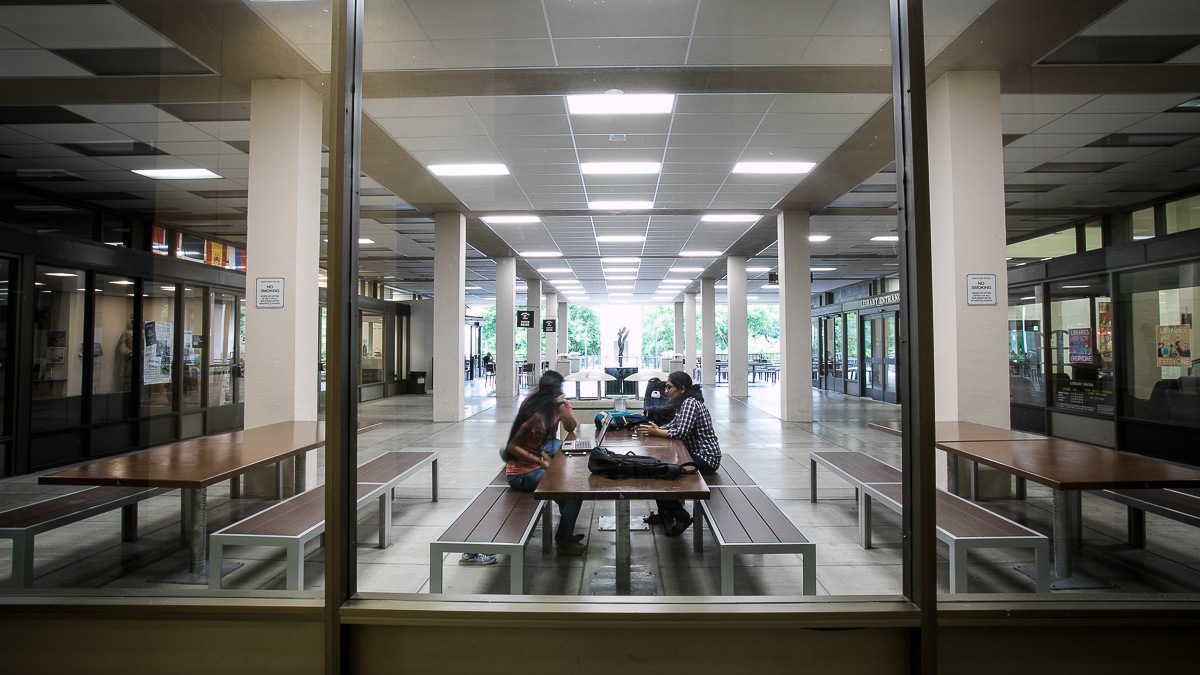 Outdated lighting in the University Library is being replaced by modern illumination, which will result in financial savings and environmental benefits. (Sacramento State/Andrea Price)
Outdated lighting in the University Library is being replaced by modern illumination, which will result in financial savings and environmental benefits. (Sacramento State/Andrea Price)
By Dixie Reid
Sacramento State’s University Library is closed because of COVID-19, making this the ideal time to retrofit the outdated lighting throughout the 275,000-square-foot building.
Crews from XL and Mark III construction companies this week began replacing 5,000 incandescent bulbs with one-third fewer, but much brighter, LED kits.
The $2.36 million project will transform the building that has the least-efficient lighting on campus, reducing energy usage by about 54.5% and saving Sac State an estimated $100,000 annually in energy costs.
The Library has a standing weekly work order to have lightbulbs changed in the building, which costs about $15,000 each year in labor and materials. Over the 50-year lifespan of the LED lights, the project will save the University an additional $750,000.
The retrofit has another important benefit. It will decrease annual greenhouse gas (GHG) emissions by approximately 386 metric tons and help the University meet the state’s goal of reducing GHG emissions to 1990 levels by this year.
Sac State has the additional sustainability goal of achieving full carbon neutrality by 2040 — five years ahead of the deadline former Gov. Jerry Brown set for California.
“We are particularly excited about the Library lighting retrofit as it benefits the University in impactful ways,” said Jonathan Bowman, vice president for Administration and Business Affairs.
“It will allow for dramatic improvement in the Library’s lighting levels, which will make it an even more conducive environment for the students who study there. And, the installation of motion-sensing and daylight-harvesting lights will allow Sacramento State to reduce its greenhouse gas emissions.”
The project is funded primarily by the CSU Chancellor’s Office with state money appropriated for campus deferred maintenance. Sac State’s Division of Administration and Business Affairs contributed $400,000 to the $2.36 million total.
By completing the retrofit this year, Sac State will earn a Sacramento Municipal Utility District rebate of around $100,000, which will be invested in future energy-reduction projects on campus.
“We always make sure that our new buildings, such as the LEED Gold-rated Ernest E. Tschannen Science Complex, are built to be as energy-efficient as possible,” said Ryan Todd, Sac State’s director for Energy and Sustainability.
“That’s as important to our GHG-reduction goals as any energy-reduction project, because one new energy-inefficient building can wipe out any progress we make with projects such as the Library lighting retrofit.”
In most cases, the existing rectangular ceiling “cans” throughout the Library will remain in place and be retrofitted with the LED kits.
“It’s very quick and cost-effective,” said Ray Keck, project manager in Facilities Management. “This likely will be the model for future lighting projects on campus.”
Illumination is measured in foot candles, and most new libraries are built with a light-intensity measurement of 28 to 32 foot candles. Prior to the retrofit, the University Library’s basement had a level of 17 to 20 foot candles.
After the retrofit, illumination throughout the six-story building will be approximately 30 to 32 foot candles.
“We hope that improving the lighting throughout the stacks and open study areas will create a better browsing and long-term studying environment for our students, whether they’re reading print materials, using a computer or a mobile device, or collaborating with classmates,” said Nicole Lawson, the Library’s associate dean for Academic Services.
